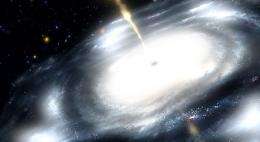July 20, 2012 report
New ideas add further mystery to why there is less lithium-7 in the universe than expected

(Phys.org) -- Thirty years ago, cosmologists Monique and François Spite of the Paris Observatory, turned the world of astrophysics upside down when they noticed that there appeared to be a distinct lack of lithium-7 in old stars in the halo of the Milky Way, which led to questions about why there wasn’t more as expected by theories about the Big Bang. Since then, more research has shown that lithium-7 simply refuses to conform to models and theories about how the universe began; there’s just not enough of it. Now, things have grown worse as researchers Fabio Iocco and Miguel Pato from Stockholm University and Technische Universität in Munich, have published a study in Physical Review Letters describing what they believe is lithium-7 production by certain black holes.
Current theory holds that some fourteen billion years ago, the Big Bang occurred and everything we know came about as a result. In those first few moments afterwards, elements were formed and persist to this day. Modeling of the Big Bang has found that all of the elements in existence conform to theories suggesting how much of each should exist. Except for lithium-7. For some reason, there is approximately just a third of what there should be and astrophysicists don’t know why. Now, new research suggests that there should be even more, maybe twice what was originally thought.
Iocco and Pato, in looking at x-ray sources that come from binary star arrangements that are thought to harbor black holes, have found what appears to be torus shaped matter (from one of the stars) swirling around and towards the gravity source. In doing the math, they calculate that the matter nears the speed at which light travels as it approaches, reaching temperatures of 100 billion K. Under those conditions, the duo suspect that helium nuclei colliding could result in the creation of lithium-7, which if true would mean that there is even more of the stuff missing than researchers had first thought. They write that if something on the order of 1% of such systems are producing helium-7, the amount of it produced would equal as much as is believed to have been created after the Big Bang.
Astrophysicists have suggested a lot of theories to explain the dearth of helium-7, but thus far, none have panned out, and none of them are proposing that the original ideas used to describe how much there should be, are wrong.
More information: Lithium Synthesis in Microquasar Accretion, Phys. Rev. Lett. 109, 021102 (2012). DOI:10.1103/PhysRevLett.109.021102 (Arxiv pre-print: arxiv.org/abs/1206.0736 )
Abstract
We study the synthesis of lithium isotopes in the hot tori formed around stellar mass black holes by accretion of the companion star. We find that sizable amounts of both stable isotopes 6Li and 7Li can be produced, the exact figures varying with the characteristics of the torus and reaching as much as 10-2M⊙ for each isotope. This mass output is enough to contaminate the entire Galaxy at a level comparable with the original, pregalactic amount of lithium and to overcome other sources such as cosmic-ray spallation or stellar nucleosynthesis.
Journal information: Physical Review Letters
© 2012 Phys.org





















